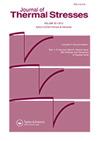对比水分条件下爆米花自交系农艺性状和根系性状配合力评价:培育耐旱基因型
IF 2.3
3区 工程技术
Q2 MECHANICS
引用次数: 0
摘要
由于这种非生物胁迫对谷物产量的重大影响,开发适应缺水条件的爆米花基因型至关重要。本试验旨在评价玉米预选品系在丰水和缺水条件下农艺性状和根系性状的配合力。采用循环双列分析方法,研究了10个品系及其杂交种的一般配合力和特定配合力对产量、膨大、膨化粒量、百粒重、穗长、穗宽、支撑根角、冠根角、支撑根数、冠根数、支撑根密度、冠根密度等性状的影响。非加性作用基因对两种水分条件下的农艺性状均有显著影响。相比之下,尽管受到环境的显著影响,但在两种条件下,根系性状的加性作用基因表达比例都更高。L61、L71和L76在一般配合力方面表现出较高的正向效应。L65/L76、L71/L76和L61/L75除了在特定配合力方面表现出令人满意的效果外,在大多数农艺性状和根系性状方面也表现出最有利的表型响应,是玉米抗旱基因型育种的理想候选品种。本文章由计算机程序翻译,如有差异,请以英文原文为准。
Assessing Combining Abilities of Popcorn Inbred Lines for Agronomic and Root Traits under Contrasting Water Conditions: Towards Developing Drought-Tolerant Genotypes
Developing popcorn genotypes that are adapted to water-deficit conditions is crucial due to the significant impact of this abiotic stress on grain yield. This study aimed to assess the combining abilities of preselected popcorn lines for agronomic and root traits under well-watered and water-stressed conditions. A circulating diallel analysis was conducted to investigate the effects of the general and specific combining abilities of 10 lines and their respective hybrids for various traits, including productivity, popping expansion, expanded popcorn volume, 100-grain weight, ear length, ear width, support root angle, crown root angle, number of support roots, number of crown roots, density of support roots, and density of crown roots. Non-additive action genes predominantly influenced the agronomic traits under both water conditions. In contrast, the root traits displayed a greater proportion of additive action gene expression under both conditions, despite being significantly affected by the environment. Lines L61, L71, and L76 demonstrated positive and high effects for general combining ability. The hybrids L65/L76, L71/L76, and L61/L75, in addition to exhibiting satisfactory effects of their specific combining ability, also displayed the most favorable phenotypic responses for most agronomic and root traits, making them ideal candidates for inclusion in popcorn breeding programs aiming to develop drought-tolerant genotypes.
求助全文
通过发布文献求助,成功后即可免费获取论文全文。
去求助
来源期刊

Journal of Thermal Stresses
工程技术-力学
CiteScore
5.20
自引率
7.10%
发文量
58
审稿时长
3 months
期刊介绍:
The first international journal devoted exclusively to the subject, Journal of Thermal Stresses publishes refereed articles on the theoretical and industrial applications of thermal stresses. Intended as a forum for those engaged in analytic as well as experimental research, this monthly journal includes papers on mathematical and practical applications. Emphasis is placed on new developments in thermoelasticity, thermoplasticity, and theory and applications of thermal stresses. Papers on experimental methods and on numerical methods, including finite element methods, are also published.
 求助内容:
求助内容: 应助结果提醒方式:
应助结果提醒方式:


